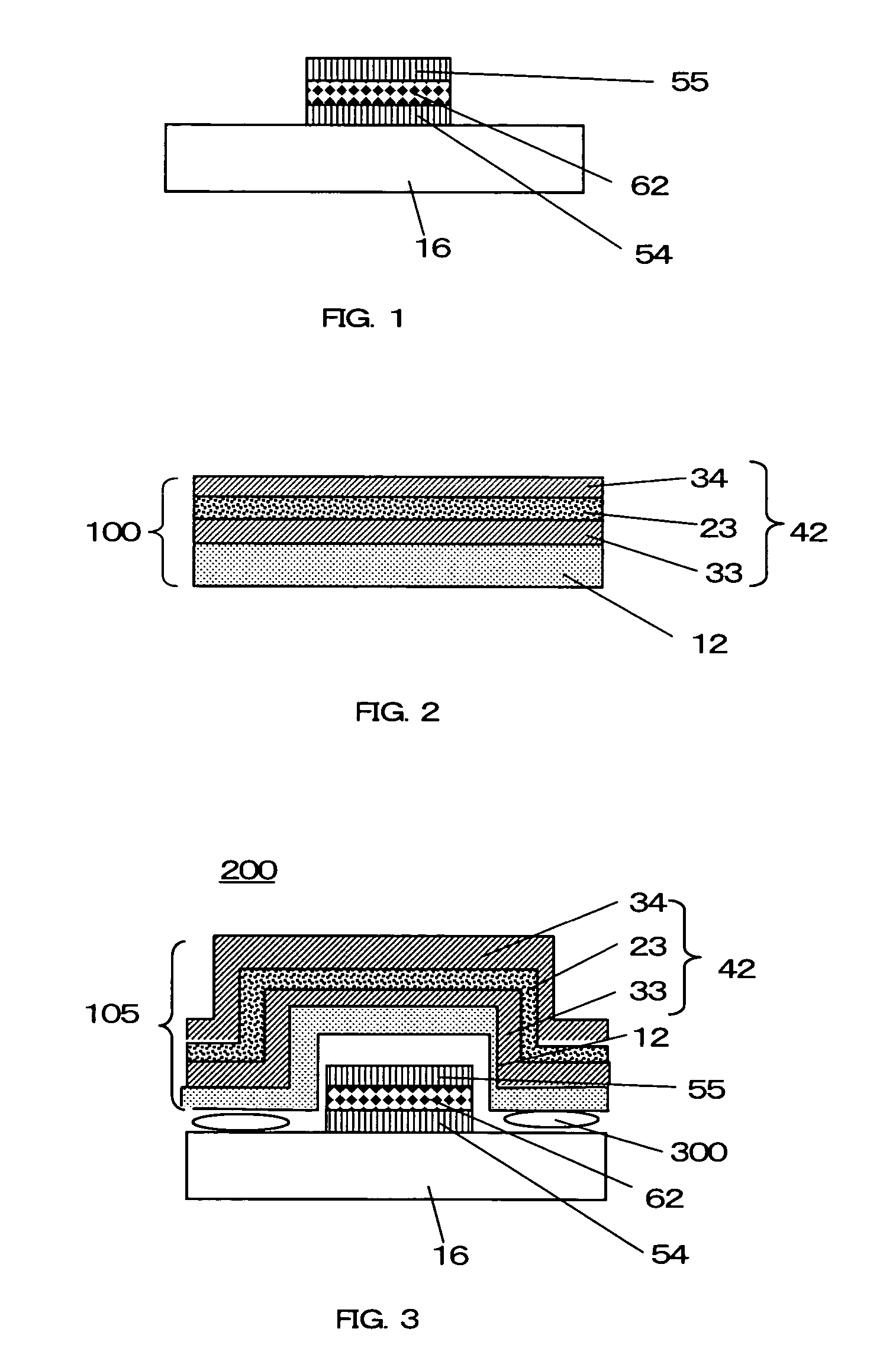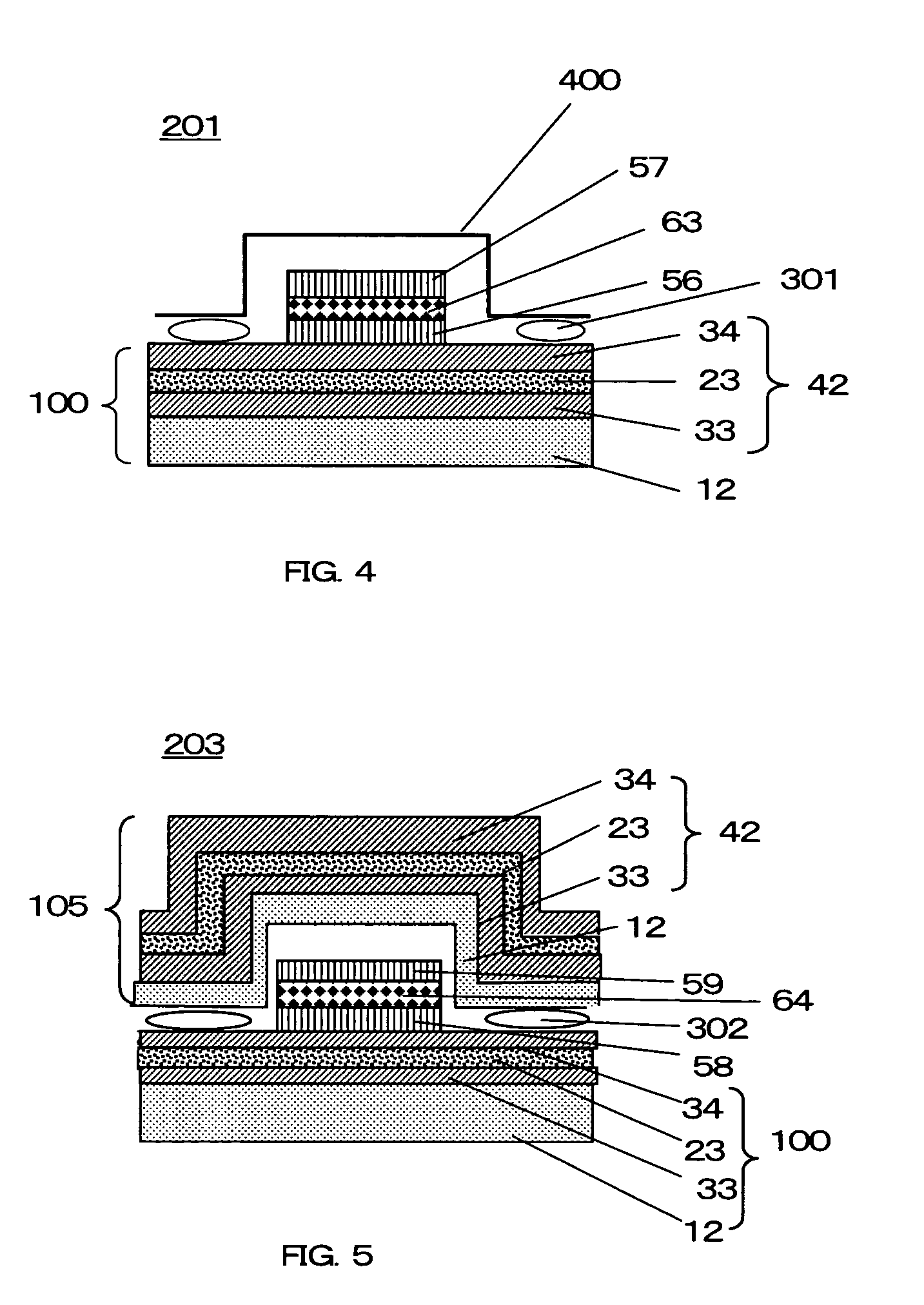Layered product, luminescence device and use thereof
a luminescence device and product technology, applied in the manufacture of discharge tubes/lamps, electrode systems, discharge tubes, etc., can solve the problems of low adhesion, defect, and easy peeling of both films, and achieve good water vapor barrier properties, good scratch resistance, and good light transmission
- Summary
- Abstract
- Description
- Claims
- Application Information
AI Technical Summary
Benefits of technology
Problems solved by technology
Method used
Image
Examples
example 1
[0185]FIG. 2 is cross section of layered product in Example 1 to 2.
[0186]In Example 1, as transparent resin substrate 12 was used film (ZEONOR FILM ZF-14, thickness=100 μm, produced by Zeon Corp.) made from norbornene based polymer being one of alicyclic structure containing polymers. SiO2 as target material was deposited on the substrate by RF sputtering process to make an inorganic film 33 having average thickness of 200 nm. Then norbornene based polymer (ZEONOR 1600 produced by Zeon Corp., “COP” in table) being one of alicyclic structure containing polymers was provided at film making rate of 90 nm / min, and SiO2 was simultaneously provided at film making rate of 10 nm / min, by electron beam vapor deposition process to make an organic film 23 having thickness of 1 μm on the above inorganic film. And SiO2 as target material was deposited on the above organic film by RF sputtering process to make an inorganic film34 having average thickness of 200 nm, which results obtaining a layere...
example 2
[0188]In EXAMPLE 2, as transparent resin substrate 12 was used film (ZEONOR FILM ZF-14, thickness=100 μm, produced by Zeon Corp.) made from norbornene based polymer being one of alicyclic structure containing polymers. The substrate was winded on a winding-off roll 501 in continuous vacuum sputtering system (direct current magnetron sputtering system) as shown in FIG. 10. Silicon dioxide was filled in target 506 and 509.
[0189]Then, vacuum exhausting from vacuum chamber 500 was begun to reach to 1×10−5 Pa in pressure. The transparent resin substrate was winded off from winding-off roll 501 at 0.1 m / min in velocity, silicon dioxide film having thickness of 200 nm was formed by sputtering from target 506 on condition that the traveled film on the deposition roll 503 was loaded with tension of 30 N. Tetrafluoromethane (CF4) and tetraethoxysilane (TEOS) were flowed from inlet line 7, at respectively 0.101 Pa·m3 / sec and 0.0676 Pa·m3 / sec (flow ratio by volume 60:40) under plasma by applyin...
example 3
[0197]FIG. 3 is cross section of luminescence device in Examples 3 to 4.
[0198]In a resistance heater with reduced pressure of 10−4 Pa or less, Al as lower electrode layer 54 having thickness of 100 nm, lithium fluoride as electron injection layer (no illustration in the figures) having thickness of 1 nm, hydroxyquinoline aluminum (thereafter, Alq3) as luminescent-material layer 62 having thickness of 60 nm, and allylamine derivative (α-NPD) as positive transport layer (no illustration in the figures) having thickness of 40 nm were deposited in turn on a glass substrate 16. This deposition rate was 0.5 nm / min. In a DC sputtering device with reduced pressure of 10−4 Pa or less, ITO as upper electrode layer 55 having thickness of 200 nm was deposited. This deposition rate was 30 nm / min.
[0199]Then, the layered product 100-1 obtained in EXAMPLE 1, in state that the transparent resin substrate was faced, was pasted with an epoxy cement 300, so as to cover from the lower electrode layer 54...
PUM
| Property | Measurement | Unit |
|---|---|---|
| volume ratio | aaaaa | aaaaa |
| wave length | aaaaa | aaaaa |
| particle diameter | aaaaa | aaaaa |
Abstract
Description
Claims
Application Information
 Login to View More
Login to View More - R&D
- Intellectual Property
- Life Sciences
- Materials
- Tech Scout
- Unparalleled Data Quality
- Higher Quality Content
- 60% Fewer Hallucinations
Browse by: Latest US Patents, China's latest patents, Technical Efficacy Thesaurus, Application Domain, Technology Topic, Popular Technical Reports.
© 2025 PatSnap. All rights reserved.Legal|Privacy policy|Modern Slavery Act Transparency Statement|Sitemap|About US| Contact US: help@patsnap.com



